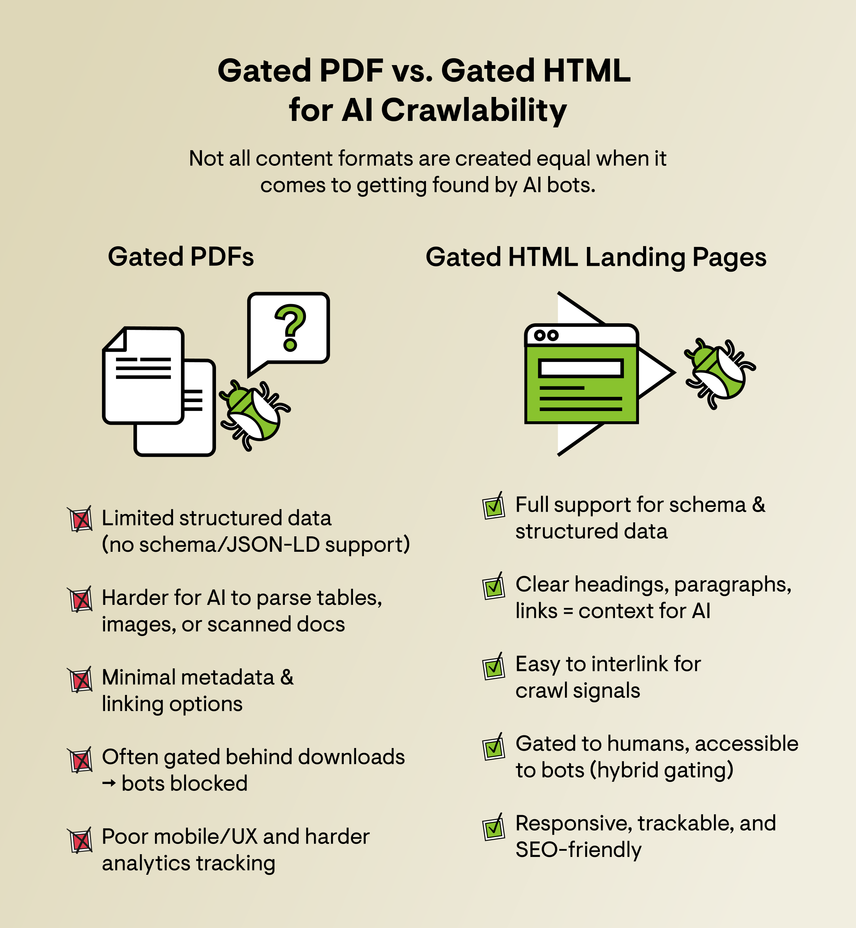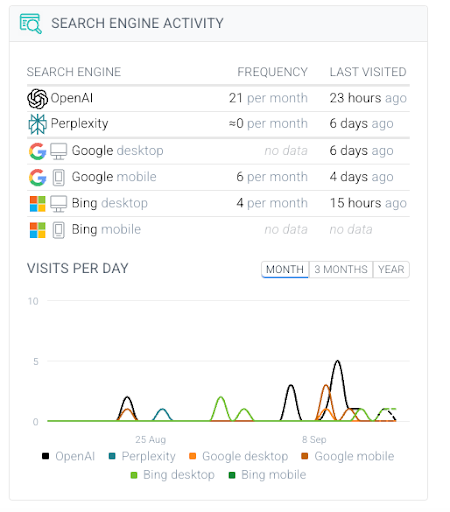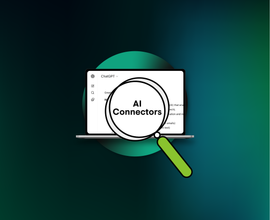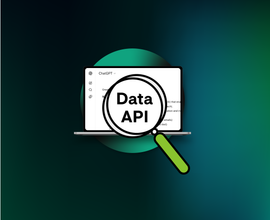What is Gated Content? And How to Make It Discoverable to AI Bots
Gated content fuels lead generation, but it can also fuel your AEO / GEO strategy—if AI bots can find it. The richest parts of your content often live behind a form, and if crawlers can’t access them, you miss out on the authority signals and mentions/citations that increase AI search visibility.
In this guide, we break down the pitfalls of PDFs, the advantages of gated HTML landing pages, and two proven strategies that balance lead gen with discoverability. You’ll also see how Conductor tackled the problem firsthand and the exact steps that led to our gated content being discovered by AI crawlers.
If you use the internet to find information, you’ve probably experienced it: you’re reading a helpful article, you click on a link to download a resource, and a form pops up asking for your details. Welcome to the world of gated content.
For marketers, gated content has always been about fueling lead generation—but in the age of AI, it also helps fuel something bigger: your AEO / GEO strategy. When LLM bots can’t crawl your gated assets, your most valuable insights stay hidden, limiting your AI search visibility. When gated content can be crawled by AI, you build the authority and trust signals that increase your odds of being cited in AI answers—while still capturing leads.
Let’s get to the heart of what makes gated content such a powerful and strategic tool.
What is gated content?
Gated content is a high-value resource that requires a user to provide information (usually their contact details) in exchange for access. It’s the digital equivalent of a "give and take" relationship. You give us your email, and we provide you with something valuable in return. It's usually a piece of content that goes deeper and offers more than a standard blog post or article.
Examples of gated content
- Whitepapers, eBooks, and research reports: These are the big ones. They dive deep into a specific topic and tend to include exclusive data and insights.
- Webinars and online courses: You get live (or pre-recorded) expert instruction.
- Templates and checklists: These are practical tools that solve a problem. Think of an SEO audit checklist or a content calendar template.
- Exclusive case studies: Detailed stories showing how a product or service helped a real customer achieve outstanding results.
Types of gated content: Paywalls vs. form fills
Let's talk about the different types of "gates" you'll encounter online. While they both require something from the user to gain access, their ultimate goals are slightly different.
- The form fill (AKA the "lead" gate): This is the gate we've been talking about. The one that asks for a user’s name, email, and perhaps a few other details. The goal is to generate a lead and initiate a conversation with the user via email, nurturing a relationship that may lead to a future sale. This is the most common type of gated content in content marketing.
- The paywall (AKA the "money" gate): This is a more direct approach. You've probably seen these on news sites or premium platforms. The goal here is to generate direct revenue. The content is the product, and you pay for access, usually through a subscription.
The benefits of gated content
Gated content isn't just a marketing tactic; it's a core strategic tool for brands. It's how you move from simply getting clicks to generating business growth. Here are a few of the key benefits of using gated content via the form fill approach.
- Lead generation (The golden ticket): This is the most significant benefit and primary reason brands—especially B2B brands—will gate content. Every time someone fills out that form, they become a lead. Which means you have a new contact to connect with, nurture, and potentially convert into a customer.
- Qualifying your audience: Not everyone will fill out a form. And that's the point. Gating content helps to qualify your audience further as they are people with intent who are likely more interested in your business or the solutions you offer. This enables you to focus your efforts on the people most likely to become paying customers.
- Building authority and trust: Creating high-quality, in-depth content featuring exclusive data or insights positions you as an expert in your industry. When you consistently produce valuable, exclusive (AKA gated) reports, eBooks, and webinars, people start to see you as the go-to source for information.
- Informing your content strategy: The data you collect (like which reports or topics generate the highest amount of downloads) can tell you a lot about your audience's interests. Which helps you create even better content and products in the future.
The AI search challenge: How to get AI bots to crawl your gated content?
One of the biggest challenges for marketers today is making sure gated or restricted assets are actually discoverable by AI/LLM bots like ChatGPT or Gemini. Historically, gated pages were deliberately set as non-indexable (AKA invisible from search engine results pages) to maximize conversions. If a crawler can't see it, it can't index it.
At Conductor, that’s why we've always been careful not to gate content we want to rank highly in SERPs, or have selectively implemented a strategic hybrid gated strategy where we provide some of the data and insights in an ungated article to rank highly for the topic, and then provide a form fill on that page to access the remaining content.
Now, brands are rethinking how to strike a balance: keep forms in place to generate leads, but still allow crawlersCrawlers
A crawler is a program used by search engines to collect data from the internet.
Learn more to access gated content to build topical authority, strengthen AEO / GEO efforts, and increase AI search visibility. These new AI bots are not just following links; they're interpreting the web in new, often more sophisticated ways and dictating AI search visibility based on these interpretations.
So, how do you make sure your valuable gated content gets found by AI crawlers, allowing it to be cited and mentioned in AI search without sacrificing key gated benefits, like lead generation?
Before we dive in, it’s worth addressing the question of why it’s critical that AI bots are discovering your gated content, along with highlighting the common pitfall of relying on gated PDFs.
Why it’s important that AI bots can discover your gated content
The gated portion of your content is often the richest and most exclusive source of insights you publish—and the part most valuable to both search engines and AI models. If bots and LLMs can’t access it, you lose out on the authority and topical depth that fuels AEO / GEO success.
Frequent visits from AI crawlers to your gated assets signal to LLMs that your brand is credible and consistently active in that topic area. More authority means higher AI visibility overall: your content is more likely to be cited, referenced, or inform AI-generated answers for related prompts.
In other words, making gated content crawlable isn’t just a technical exercise—it’s foundational to building visibility in AI search and driving long-term AEO / GEO impact.
Now, let’s discuss why gated PDFs are holding brands back from getting this insight-rich content crawled.
Why PDFs pose added challenges for AI crawlability
While PDFs have long been a go-to format for whitepapers and reports, they create unique challenges for AI crawlability.
PDFs create friction for AI crawlers. Unlike HTML landing pages, PDFs lack rich structured dataStructured Data
Structured data is the term used to describe schema markup on websites. With the help of this code, search engines can understand the content of URLs more easily, resulting in enhanced results in the search engine results page known as rich results. Typical examples of this are ratings, events and much more. The Conductor glossary below contains everything you need to know about structured data.
Learn more, internal linking, and consistent metadata that help bots understand context. Parsing text, images, or tables from PDFs is also more error-prone, which means important details can be missed.
When gated, the challenges multiply: most crawlers can’t get past a download form or login wall to access the file at all. Even adding a direct link on a sitemap to the PDF from your CMS library poses challenges, as this doesn’t guarantee the AI bots will understand or crawl the page. As a result, even your most valuable research may never be surfaced in AI-generated answers.
That’s why many enterprise brands, including the team at Conductor, have pivoted away from gated PDFs and toward gated landing pages. With HTML, you maintain control over schema, links, and crawl signals—ensuring AI bots can actually find and interpret your best content while still capturing leads from human users.

Now that we’ve explained why enterprise brands need their valuable gated content crawlable and addressed the PDF problem, let’s discuss the two effective strategies for making your gated content discoverable to AI crawlers—and by extension, strengthen your AEO / GEO strategy while improving AI visibility for your domain.
Strategy #1: The content on the page method (Hybrid gating)
This strategy is a more technical approach that relies on the crawler’s ability to read the underlying code of your webpage.
- How it works: The gated content (the full text of your research report, eBook, checklist, etc.) is technically loaded onto the same page as the form. It's simply hidden from the human user's view until they submit the form. This is typically done using an overlay (a lightbox or modal) that sits on top of the content, or by using CSS to hide the content's div until a form submission triggers a change.
- The SEO advantage: Since the content is technically in the page's HTML source code, a search engine or AI crawler can read and index it. The bot sees the full text, understands what the page is about, and can use that information in its search results and AI-generated answers.
- Your action: When building your gated content page, ensure the full text of the asset is present in the page's code, not behind a separate URL that a form submission redirects you to.
Strategy #2: The separate URL method (Internal linking)
This strategy is a more traditional SEO approach, but it's just as effective, especially for bots that follow a standard crawling process.
- How it works: The gated content lives on its own dedicated URL, separate from the landing page or hybrid article with the form. When a user submits the form, they are redirected to this URL to access the content. The key here is to make that private, noindex URL accessible to crawlers.
- The SEO advantage: Even though the URL is marked as noindex and isn't publicly linked on your main navigation, you can strategically link to it in a way that only search engine bots can follow. This tells the bots where the content is located so they can find it and index it.
- Your action:
- Contextual links: Add links to the gated content's URL from highly relevant, ungated blog posts, articles, or other key pages on your site. This passes authority and helps crawlers discover the URL.
- XML sitemaps: Include the URL for your gated content in your website's XML sitemap. This is a direct signal to search engines that says, "Hey, this page exists and is important!"
- Internal resource hub: Create a private "Resource Hub" or HTML sitemap page on your website that lists the URLs of all of your gated content pages. This page doesn't have to be public, but it can be included in your sitemap or footer navigation, allowing bots to find all your valuable assets from a single location.
Both of these strategies will provide a steady stream of valuable leads and enhance your brand's authority in AI-powered search.
How to check the crawlability of gated content or a website?
The only catch to the strategies outlined above? Without dedicated real-time monitoring technology, it’s nearly impossible to know if these strategies are working. 24/7 crawl checks and alerts are now critical to confirm whether gated assets are being found—or left in digital obscurity.
With traditional SEO, you can check server logs or Google Search ConsoleGoogle Search Console
The Google Search Console is a free web analysis tool offered by Google.
Learn more to confirm that Googlebot has visited a page. For AI search and AEO / GEO, that level of certainty just isn’t there. The user-agents of AI crawlers are new, varied, and often missed by standard analytics and log file analyzers.
That’s why the only way to know if your site—and gated content specifically—is truly crawlable by AI is to have a dedicated, always-on monitoring platform that specifically tracks AI bot activity, along with traditional search engineSearch Engine
A search engine is a website through which users can search internet content.
Learn more crawlers, like Conductor Monitoring.
Without a solution that can identify crawlers from OpenAI, Perplexity, and other answer engines, you’re left guessing. Getting direct insight into your site’s crawlability is the first step; once you can see AI crawler activity on your site, you can leverage the benefits of real-time data to optimize your strategy and ensure gated content is discoverable and able to be cited and mentioned.
Learn how to ensure AI search readiness and AI crawlability across your entire site with our latest actionable guides.
Conductor.com case study: How Conductor made gated content crawlable to AI search
So, how does this all work in practice? Let me walk you through our experience with a gated guide on Conductor.com.
Based on our current setup, we moved forward with Strategy #2: The separate URL method. Our goal was to create an in-depth, gated AI visibility guide and use it as a lead generator. The form was located on the hybrid article page (see it here), but the actual content was accessible through a separate, hidden URL that could only be reached by completing the form.
Our first attempt at making the content discoverable by AI bots was simple. We did what any good SEO would do: we made sure the gated guide’s URL was included in our XML sitemap. After all, the sitemap is a direct line to search engine crawlers, so this should work, right?
We waited. And waited. Leveraging Conductor Monitoring, we saw little to no visits from AI bots like ChatGPT or Perplexity. Our content was still not being used in the AI-generated answers like we had hoped for.
We decided to get more proactive. We realized that an XML sitemap is like a phone book—it tells bots where to find something, but it doesn't indicate if it's important. We needed to provide more context.
Our second attempt was a two-part strategy:
- We went to our high-value, relevant Academy articles and added contextual links to the gated guide’s URL, using descriptive anchor text. This signaled to the bots that this guide was highly relevant to a specific topic.
- We also created a simple HTML sitemap (a publicly-facing page with links to all of our important content) and included a link to it in our website's footer. This provided a human-readable, easily crawlable roadmap to all of our most valuable assets, including our gated guide.
As soon as we implemented these changes, something incredible happened: AI bots started to visit and crawl the page. Our log files now show a consistent stream of visits from these crawlers, as you can see in the screenshot from Conductor Monitoring below.

This experience taught us a powerful lesson: to get gated content found by AI, you must actively signal its importance through a strategic, human-centric linking structure throughout your site and an HTML sitemap.
The takeaways
Gated content can be a powerful tool for lead generation, but it's also a delicate balance. You can't gate everything. A strong AEO / GEO strategy requires not only a mix of ungated and gated resources, but also ensuring the gated portion is crawlable by AI bots to maximize AI visibility. Free, high-quality articles and on-site content attract traffic, while crawlable gated content builds deeper authority that LLMs and AI models reward.
Think of it this way: the articles or blog posts are the free samples. They get people (or bots) to your website and show them what you're all about. The gated content is the full-sized meal—the high-value resource they get once they've decided to invest in what you offer.
The key is to use gated content strategically. Offer something so unique and valuable that people will happily exchange their email address for it. It's all about providing incredible value and building a relationship of trust from the very first interaction. From an AI search perspective, it’s essential to adapt your gated strategy to allow AI bot crawlers to discover and crawl your gated content, allowing you to benefit from increased brand awareness and topical/domain authority.
The next time you see a form pop up, don't just see a barrier; see an opportunity. You're not just giving away your email; you're gaining access to something valuable. For the businesses using it, they're not just collecting addresses; they're building a community of people who genuinely care about what they do.








